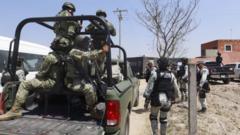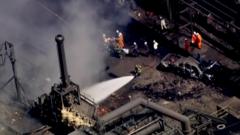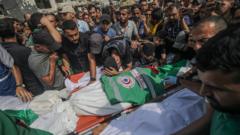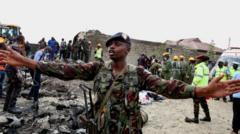An Air India flight bound for London crashed shortly after takeoff in Ahmedabad, resulting in over 200 fatalities and a single confirmed survivor. With the investigation underway, the aviation community grapples with the implications and causes behind this tragic event.
Tragedy Strikes: Air India Plane Crash Claims Over 200 Lives in Ahmedabad

Tragedy Strikes: Air India Plane Crash Claims Over 200 Lives in Ahmedabad
A Boeing Dreamliner aircraft plummets after takeoff in Ahmedabad, igniting a catastrophe that has left families shattered and the country grieving.
---
Ahmedabad, India - A devastating incident struck the western city of Ahmedabad on Thursday when an Air India flight, a Boeing 787 Dreamliner, crashed less than a minute after taking off for London. The plane was carrying 242 individuals in total, including passengers and crew members. Currently, official reports indicate that at least 204 lives have been lost, including multiple students at a nearby medical college, with the first responders ensuring to identify victims efficiently as the rescue operations unfold.
In a heartbreaking moment, India’s Home Minister Amit Shah confirmed that one passenger had survived, sparking hopes amidst a sea of grief. The survivor was reportedly aided by emergency services at the site of the crash, where the plane struck a medical college approximately a mile southwest of Sardar Vallabhbhai Patel International Airport. Eyewitness accounts and verified footage reveal the chaos and aftermath, with parts of the aircraft strewn across the area and emergency responders working tirelessly to clear the wreckage.
Local authorities have reported that recovery operations are fraught with danger due to unstable structures affected by the crash. This tragic incident marks one of the deadliest aviation disasters in India since the mid-1990s, raising significant questions regarding aviation safety and the operational history of the Boeing 787 Dreamliner, a model that had, until now, been free of fatal crashes.
As investigators begin to sift through the debris, the focus will shift towards understanding what caused the aircraft to descend so abruptly. Initial analyses of the flight patterns show unusual characteristics, with experts warning against premature assumptions, emphasizing the multi-faceted nature of air incidents which often involve a convergence of mechanical failures, human error, or environmental factors.
Global responses have poured in, including statements from airline and aviation officials. Billions in emergency aid are anticipated to support the affected families, while the Civil Aviation Ministry is taking steps to provide critical information regarding the passenger list and recovery efforts as the country mourns this catastrophic loss.
The Boeing 787 has previously weathered scrutiny over quality control and safety concerns, and this crash inevitably leads to renewed calls for comprehensive investigations. As families await news of their loved ones, thoughts on aviation safety reform dominate discussions following this tragic event.
Ahmedabad, India - A devastating incident struck the western city of Ahmedabad on Thursday when an Air India flight, a Boeing 787 Dreamliner, crashed less than a minute after taking off for London. The plane was carrying 242 individuals in total, including passengers and crew members. Currently, official reports indicate that at least 204 lives have been lost, including multiple students at a nearby medical college, with the first responders ensuring to identify victims efficiently as the rescue operations unfold.
In a heartbreaking moment, India’s Home Minister Amit Shah confirmed that one passenger had survived, sparking hopes amidst a sea of grief. The survivor was reportedly aided by emergency services at the site of the crash, where the plane struck a medical college approximately a mile southwest of Sardar Vallabhbhai Patel International Airport. Eyewitness accounts and verified footage reveal the chaos and aftermath, with parts of the aircraft strewn across the area and emergency responders working tirelessly to clear the wreckage.
Local authorities have reported that recovery operations are fraught with danger due to unstable structures affected by the crash. This tragic incident marks one of the deadliest aviation disasters in India since the mid-1990s, raising significant questions regarding aviation safety and the operational history of the Boeing 787 Dreamliner, a model that had, until now, been free of fatal crashes.
As investigators begin to sift through the debris, the focus will shift towards understanding what caused the aircraft to descend so abruptly. Initial analyses of the flight patterns show unusual characteristics, with experts warning against premature assumptions, emphasizing the multi-faceted nature of air incidents which often involve a convergence of mechanical failures, human error, or environmental factors.
Global responses have poured in, including statements from airline and aviation officials. Billions in emergency aid are anticipated to support the affected families, while the Civil Aviation Ministry is taking steps to provide critical information regarding the passenger list and recovery efforts as the country mourns this catastrophic loss.
The Boeing 787 has previously weathered scrutiny over quality control and safety concerns, and this crash inevitably leads to renewed calls for comprehensive investigations. As families await news of their loved ones, thoughts on aviation safety reform dominate discussions following this tragic event.





















